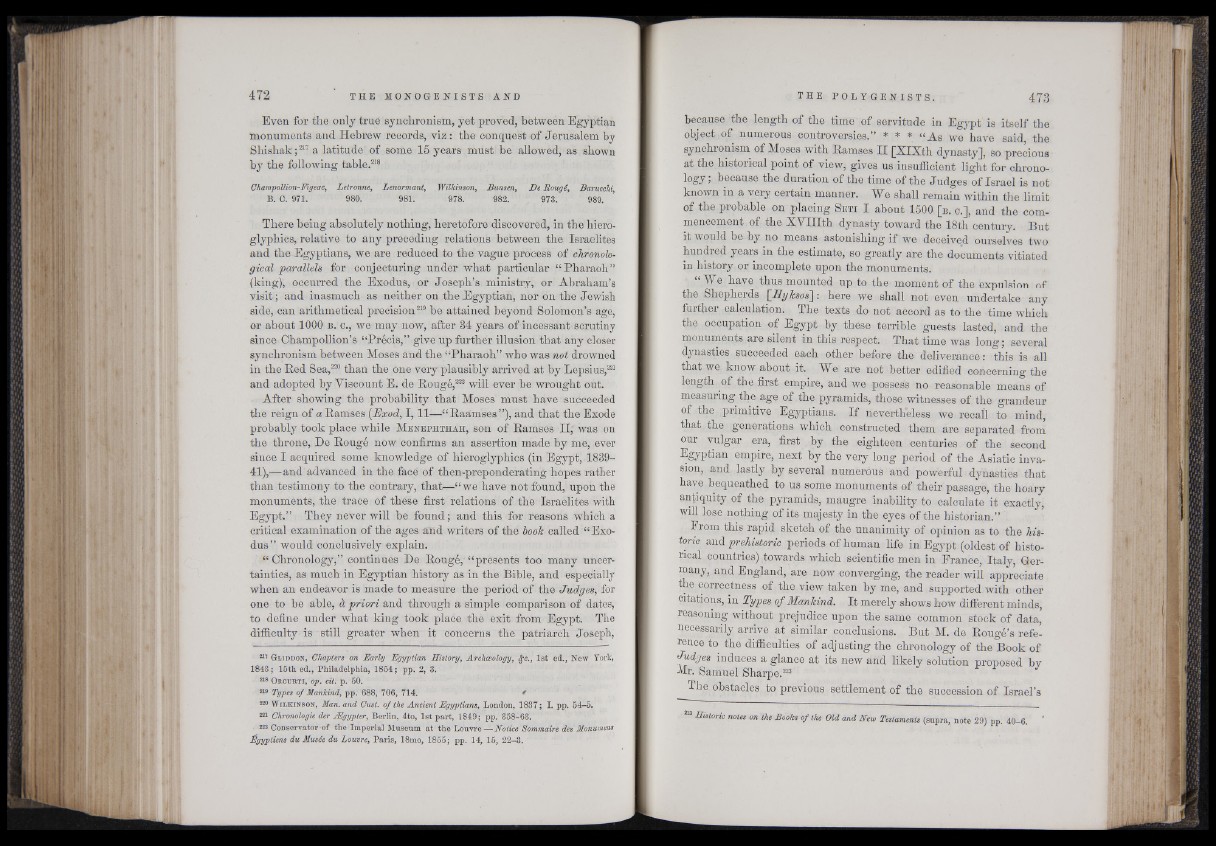
Even for the only true synchronism, yet proved, between Egyptian
monuments and Hebrew records, viz : the conquest of Jerusalem by
Shishak;217 a latitude of some 15 years must be allowed, as shown
by the following table.218
Champollion-Figeac, Letronne, Lenormant, Wilkinson, Bunsen, De Rougé, Barucchi,
B. C. 971. 980. 981. 978. 982. 1 973. 989.
There being absolutely nothing, heretofore discovered, in the hieroglyphics,
relative to any preceding relations between the Israelites
and the Egyptians, we are reduced to the vague process of chronological
parallels for conjecturing under what particular “ Pharaoh”
(king), occurred the Exodus, or Joseph’s ministry, or Abraham’s
visit; and inasmuch as neither on the Egyptian, nor on the Jewish
side, can arithmetical precision219 be attained beyond Solomon’s age,
o r about 1000 b . c., we may now, after 34 years of incessant scrutiny
since Champollion’s “Précis,” give up further illusion that any closer
synchronism between Moses and the “Pharaoh” who was not drowned
in the Red Sea,220 than the One very plausibly arrived at by Lepsius,221
and adopted by Yiscount E. de Rougé,222 will ever be wrought out.
After showing the probability that; Moses must have succeeded
the reign of «Ramses (Exod, 1 ,11—“Raamses”), and that the Exode
probably took place while Menepiithah, son of Ramses H,' was on
the throne, De Rougé now confirms an assertion made by me, ever
since I acquired some knowledge of hieroglyphics (in Egypt,. 1839-
41),■—and advanced in the face of then-preponderating hopes rather
than testimony to the contrary, that—“we have not found, upon the
monuments, the trace of these first relations of the Israelites with
Egypt.” They never will be found ; and this for reasons which a
critical examination of the ages and writers of the book called “Exodus”
would conclusively explain.
“ Chronology,” continues De Rougé, “presents too many uncertainties,
as much in Egyptian history as in the Bible, and especially
when an endeavor is made to measure the period of the Jwdyes,ifor
one to be able, à priori and through a simple comparison of dates,
to define under what king took place the exit from Egypt: The
difficulty is still greater when it concerns the patriarch Joseph,
217 G l id d o n , Chapters on Early Egyptian History, Archaeology, ^c., 1st ed., New York,
1843; 15th ed., Philadelphia, 1854; pp. 2, 3.
218 O r c u r t i , op. cit. p. 50.
219 Types of Mankind, pp. 688, 706, 714. *
220 W i l k in s o n , Man. and Oust, of the Ancient Egyptians, London, 1837; I . pp. 54r-5.
221 Chronologie der Ægypter, Berlin, 4to, 1st part, 1849; pp. 358-63.
222 Conservator-of the Imperial Museum at the Louvre—Notice Sommaire des Monumens
Égyptiens du Musée du Louvre, Paris, 18mo, 1855; pp. 14, 15, 22-3.
because the length of the time of servitude in Egypt is itself the
object:of numerous controversies.” * * * “As we have said the
synchronism of Moses with Ramses H [IXTYth dynasty], so precious
at the historical point of view, gives us insufficient light for chronology;
because the duration of the time of the Judges of Israel is not
known in a very certain manner. We shall remain within the limit
of the probable on placing S e t i I about 1500 [ b . c.] , and the commencement
of the XVHIth dynasty toward the 18th century. But
it would be by no means astonishing if we deceived ourselves two
hundred years in the estimate, so greatly are the documents vitiated
in history or incomplete upon the monuments.
“We have thus mounted up to the moment of the expulsion of
the Shepherds [Eyksos]: here we shall not even undertake any
further calculation. The texts do not accord as to the time which
the ^occupation of Egypt by these terrible guests lasted, and the
monuments are silent in this respect. That time was long; several
dynasties succeeded each other before the deliverance: this is all
that we know about it. We are not better edified concerning the
length of the first empire, and we possess no reasonable means of
measuring thu age of the pyramids, those witnesses of the grandeur
of the primitive Egyptians. If nevertheless we recall to mind,
that, the generations which constructed them are separated from
our vulgar era, first by the eighteen centuries of the second
Egyptian empire, next by the very long period of the Asiatic invasion,
and lastly by several numerous and powerful dynasties that
have bequeathed to us some monuments of their passage, the hoary
antiquity of the pyramids, maugre inability to calculate it exactly,
will lose nothing of its majesty in the eyes of the historian.”
From this rapid sketch of the unanimity of opinion as to the historic
and prehistoric periods of human life in Egypt (oldest of historical
countries) towards which scientific men in France, Italy, Germany,
and England, are now converging, the reader will appreciate
the correctness of the view taken by me, and supported with other
citations, in Types of Mankind. It merely shows how different minds,
reasoning without prejudice upon the same common stock of data,
necessarily arrive at similar conclusions. But M. de Rougé’s reference
to the difficulties of adjusting the chronology of the Book of
Judges induces a glance at its new and likely solution proposed by
Mr. Samuel Sharpe.223
The obstacles to previous settlement of the succession of Israel’s
Historic notes on the Books of the Old and New Testaments (supra, note 29) pp. 40-6.